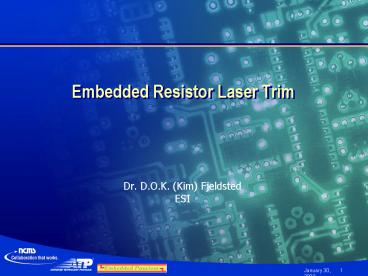Embedded Resistor Laser Trim - PowerPoint PPT Presentation
1 / 35
Title:
Embedded Resistor Laser Trim
Description:
The resistor to be trimmed is connected to a high-speed test and measurement system ... SCAN. DOUBLE. PLUNGE. 18. 18. January 30, 2003. Probing a Circuit. 19 ... – PowerPoint PPT presentation
Number of Views:103
Avg rating:3.0/5.0
Title: Embedded Resistor Laser Trim
1
Embedded Resistor Laser Trim
- Dr. D.O.K. (Kim) Fjeldsted
- ESI
2
Worldwide Chip-R Forecast
Billions Of Units
SOURCE Prismark Partners LLC Paumonok Group
1/02
3
Worldwide Chip-R Forecast By Package Size
SOURCE Paumanok Group Prismark Partners LLC,
1/02
4
Embedded Resistor Roadmap
Market Status
Research Development
Prototype
Production
Exploration
Packages Small Modules
Parallel Termination
Markets
Cell Phones
Motherboards
Trim Req
Medium
None
High
Low
Max Value
100 kW
500 W
500 kW
10 untrimmed 1 trimmed
Tolerances
5 trimmed
20 untrimmed
5
Worldwide Forecast Cellphones
SOURCE Custer Consulting, 6/02
6
Embedded Resistor Technologies Roadmap
7
Embedded Resistor Tolerances
SOURCE Greg Lucas 11/01, and others.
8
Why Trim?
SOURCE Gould, 5/01
9
Achieving Tighter Tolerances
- Without trimming
- Tolerances of 8 16 on embedded resistors
- With laser trimming
- Better than 1 tolerance on trimmed resistors
10
Laser Trim In the PWB Process Flow
11
Process Related Tolerance Drift
Tolerance
1 5
0
Trim
Subsequent steps (overcoat, lamination, reflow,
etc.)
12
The Trimming Process
- The resistor to be trimmed is connected to a
high-speed test and measurement system - The laser micromachines a cut in the resistor
material - When the resistor reaches its target value, the
measurement system signals the laser to stop
cutting
13
Before After Laser Trimming
14
Change In Resistance With Distance Trimmed
15
Double Plunge Trim
1
2
16
L-Cut Trim
Target R Value
R in W
Before trim value
Distance of trim
2
1
17
Types Of Laser Trims
SERPENTINE
18
Probing a Circuit
19
Probing a Circuit (contd)
20
Probing a Circuit (contd)
21
Probing a Circuit (contd)
22
Probe and Trim Guidelines
- Board and panel layout
- A systematic regular x-y layout of multi-up
boards on a panel is preferred - Pad placement
- A systematic, regular x-y layout of test pads is
preferred - Test pads should be arranged in generally
repeated patterns - Test pads should be proximal to the resistors
- Probe access (horizontal or vertical) to the test
pads should not hinder laser view or access
(overhead, vertical) to any resistors of trim
interest - Pad size
- Robust test probes for this application have
typical tip diameters of 0.006 0.015 (150375
µm) - Resistors less than approximately 200 W may
require 4 point probing (full Kelvin) for 1
tolerance testing - Minimum pad size should be 0.025 (625 µm)
diameter to accommodate typical test probes - Pad sizes greater than 0.050 (1.25 mm) diameter
significantly improve test probe placement
accuracy - Resistor size
- The laser spot is approximately 0.001 0.007
(25 175 µm) diameter depending on the subject
materials - High accuracy trims (tolerance ? 0.5) are best
obtained for resistors larger than 0.020 x 0.020
in2 (500 x 500 µm2) - Resistors as small as 0.010 x 0.010 in2 (250 x
250 µm2) are trimmable, with tolerances dependent
on material and resistance values
23
Panel Technologies Roadmap
24
Embedded Passive Market
Model 4700 Embedded Passive Laser Trimming System
25
Laser Trim on Printed Circuit Board (PCB)
26
Embedded Resistor Laser Trim
27
Laser Trim on Printed Circuit Board (PCB)
28
Metal Thin Film
29
Embedded Resistor Laser Trim
30
Embedded Resistor Laser Trim
31
Process Component Analysis
32
Panel of Multiple up Boards
- Step and repeat
- in 6 rows and
- 6 columns
- 110 resistors/board
- 3,960 R/Panel
- (1.41 R/cm2)
33
Multiple up Boards and Modules
- 18 resistors/module
- 108 modules/board
- 16 boards/panel
- 31,104 R/Panel
- (11.08 R/cm2)
34
Cost of Ownership Model
35
Cost Model Sensitivities































